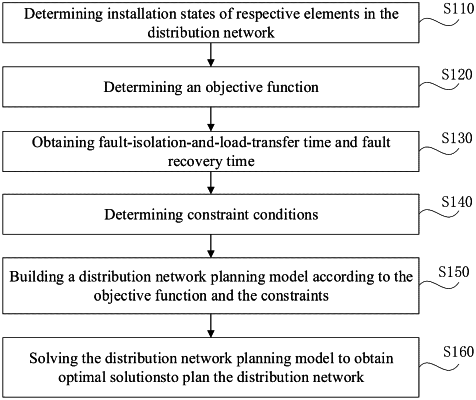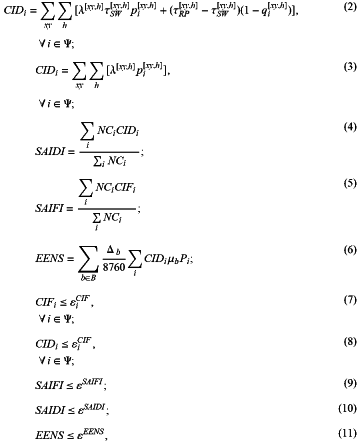| CPC G06F 30/18 (2020.01) [G06Q 10/06313 (2013.01); G06Q 50/06 (2013.01); H02J 3/00125 (2020.01); G06F 2111/04 (2020.01); G06F 2111/06 (2020.01); G06F 2113/04 (2020.01); G06F 2119/02 (2020.01); G06Q 50/08 (2013.01); H02J 2203/20 (2020.01); Y02E 60/00 (2013.01); Y04S 40/20 (2013.01)] | 4 Claims |

|
1. A method for planning a distribution network with reliability constraints based on a feeder corridor, the distribution network comprising at least one feeder line, a circuit breaker that is capable of interrupting a fault current being installed at a head of each feeder line, each feeder line being divided into a plurality of feeder segments through at least one interconnection switch that is not capable of interrupting the fault current, at least one of the plurality of feeder segments being contained in the feeder corridor, and 0 or 1 interconnection switch provided between each feeder line and other feeder line, the method comprising:
determining installation states of respective elements in the distribution network, the elements comprising at least one of the feeder line, the feeder segments, the feeder corridor, the interconnection switch, a transformer, a substation, the circuit breaker, and switching devices;
determining an objective function, the objective function being an objective function of minimizing a total investment cost CTotal of the distribution network, as expressed by the following formula (1):
 where
Cf indicates a construction cost of the circuit breaker and a recloser in a feeder line f,
lf is a 0-1 variable indicating whether to build the feeder line f, with lf=1 indicating to build and lf=0 indicating not to build,
Cijf indicates a construction cost of the feeder segment of the feeder line f that is contained in the feeder corridor ij,
lijf is a 0-1 variable indicating whether to build the feeder segment of the feeder line f that is contained in the feeder corridor ij, with lijf=1 indicating to build and lijf=0 indicating not to build,
Cij indicates an occupation cost the feeder corridor ij,
lij is a 0-1 variable indicating whether to occupy the feeder corridor ij, with lij=1 indicating to occupy and lij=0 indicating not to occupy,
cifg indicates a construction cost of the interconnection switch between the feeder line f and a feeder line g at a node i,
lifg is a 0-1 variable indicating whether to build the interconnection switch between the feeder line f and the feeder line g at the node i, with lifg=1 indicating to build and lifg=0 indicating not to build,
Ctr indicates a construction cost of a transformer tr,
utr is a 0-1 variable indicating whether to build the transformer tr, with utr=1 indicating to build and utr=0 indicating not to build,
CSS indicates a construction cost of a substation SS,
uss is a 0-1 variable indicating whether to build the substation SS, with uss=1 indicating to build and uss=0 indicating not to build, and
ωSAIDI indicates a reliability cost, in which ω is a weighting factor ranging from 1 to 100, and SAIDI indicates a system average interruption duration index;
obtaining fault-isolation-and-load-transfer time and fault recovery time in a case where the feeder segment of each feeder line that is contained in each feeder corridor fails, by the following steps:
opening a circuit breaker upstream of a feeder segment to interrupt the fault current upon the feeder segment of the feeder line that is contained in the feeder corridor fails, to cause power outage in downstream nodes of the circuit breaker;
operating all the switching devices and circuit breakers in the distribution network manually to recover the power supply at the outage nodes to the maximum extent; and
recovering the fault feeder segment, and restoring the distribution network to its original structure by operating the switching devices and the circuit breaker,
wherein, the fault-isolation-and-load-transfer time refers to a time period from the time of failure to the time when the circuit breakers and the switching devices are operated manually for fault isolation and the power is restored to the affected nodes, and
wherein, the fault recovery time refers to a time from the time of failure to the time when the fault is restored;
determining constraint conditions based on the obtained fault-isolation-and-load-transfer time and fault recovery time, the constraint conditions comprising reliability constraints, as expressed by the following formulas (2) to (11):
 where
CIDi indicates a customer interruption duration at the node i,
λ[xy,h] indicates an annual failure rate of a feeder segment of a feeder line h that is contained in the feeder corridor xy,
τSW[xy,h] indicates the fault-isolation-and-load-transfer time in a case where the feeder segment of the feeder line h that is contained in the feeder corridor xy fails,
τRP[xy,h] indicates the fault recovery time in the case where the feeder segment of the feeder line h that is contained in the feeder corridor xy fails,
CIFi indicates a customer interruption frequency at the node i,
NCi indicates a number of the customers at the node i,
SAIFI indicates a system average interruption frequency index,
SAIDI indicates a system average interruption duration index,
ASAI indicates an average service availability index,
EENS indicates an expected energy not supplied,
B indicates a set of all load levels,
Δb indicates annual hours for which a load level b lasts, b∈B,
μb indicates a peak load ratio of the load level b, with μb≤1,
Li indicates a peak load at the node i,
εiCIF indicates an upper limit of the annual average interruption frequency at the node i,
εiCID indicates an upper limit of the annual average interruption duration at the node i,
εSAIFI indicates an upper limit of the system average interruption frequency index,
εSAIDI indicates an upper limit of the system average interruption duration index, and
εEENS indicates an upper limit of the expected energy not supplied;
building a distribution network planning model based on mixed integer linear programming model according to the objective function and the constraints;
solving the distribution network planning model built solving the distribution network planning model built to obtain optimal solutions of the variable lf indicating whether to build the feeder line f, the variable lijf indicating whether to build the feeder segment of the feeder line f that is contained in the feeder corridor ij, the variable lij indicating whether to occupy the feeder corridor ij, the variable lifg indicating whether to build the interconnection switch between the feeder line f and the feeder line g at the node i, the variable utr indicating whether to build the transformer tr, and the variable uss indicating whether to build the substation feeder SS, as planning states of the feeder line, the feeder segment, the feeder corridor, the interconnection switch, the transformer and the substation, and to obtain optimal solutions of the customer interruption duration CIDi at the node i, the customer interruption frequency CIFi at the node i, the system average interruption duration index SAIDI, the system average interruption frequency index SAIFI, and the expected energy not supplied EENS, as reliability indexes, so as to plan the distribution network based on the planning states and reliability indexes.
|